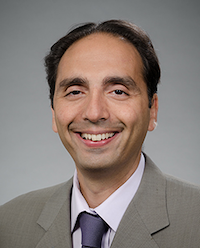Article
Long-term Consequences of Sustained Virologic Response for HCV Infection
Author(s):
Investigators recognize sustained virologic response to DAAs for hepatitis C infection as valid clinical endpoint of treatment, but question how it relates to long-term health.

George Ioannou, MD, MS
Investigators recognize sustained virologic response (SVR) of hepatitis C virus (HCV) as a valid clinical endpoint of direct-acting antiviral (DAA) treatment, but question how it relates to long-term health and to the hepatic and extrahepatic complications of HCV infection.
George Ioannou, MD, MS, Division of Gastroenterology, Veterans Affairs Puget Sound Healthcare System and University of Washington, Seattle, and Jordan Feld, MD, MPH, Toronto Centre for Liver Disease, University Health Network, Sandra Rotman Centre for Global Health, University of Toronto, sought answers in a critical review of the data on short- and long-term benefits and potential negative effects of DAA treatment.
"Documentation of the potential benefits of viral clearance is critical to determine the true utility of HCV therapy," Ioannou and Feld declare. "However, even if SVR leads to unequivocal clinical benefit, there may be significant methodological challenges to prove this case."
The investigators found that clinical trials that compared outcomes of patients who did or did not receive DAA treatment, compiled in a review, had a mean combined intervention and follow-up period of only 34 weeks, which they judged insufficient to ascertain differences in long-term benefit and mortality.
"The only meaningful conclusion of this systematic review was that we cannot determine he long-term effects of DAA-based antiviral treatments from available randomized controlled trials," Ioannou and Feld indicated.
Instead, the investigators turned to long-term observational studies. They distinguished these into 3 categories but found potential confounding factors in each. Studies in one category compared clinical outcomes among patients who achieved DAA-induced SVR with those who did not and were limited by confounding bias. Another group of studies compared patients treated with DAAs to those receiving interferon (IFN)-based regimens, with the primary confounding factor of patients with advanced liver disease not receiving the IFN treatments. A third group compared those treated with DAAs to those not receiving treatment, but these were liable to have considerable selection bias according to the investigators.
From these data sources, Ioannou and Feld determined the significance of attaining SVR for long-term health, and/or the adequacy of available studies to allow such determination, including the following:
- There were indications that attaining SVR reduces all-cause mortality, but Ioannou and Feld were unable find explanation for the reduction, due to lack of information on the causes of death.
"These findings are of great importance and have major policy implications," they pointed out, "they could justify broadening access to all infected individuals regardless of liver disease stage."
- Although an increasing number of patients with decompensated cirrhosis are receiving DAA treatment and attaining SVR, their long-term outcomes remain unclear, according to the investigators.
"It will be important to determine whether their liver function can improve, whether there is a point of no return, and what that point is in individual patients," Ioannou and Feld wrote.
- The investigators found consistent evidence, from increasingly long study follow-up periods, that successful DAA treatment is followed by regression of fibrosis. They caution, however, that liver stiffness assessed by transient elastography may decrease abruptly during and immediately after DAA treatment due to reduced inflammation and may contribute to overestimates of fibrosis regression.
- The relation between SVR and hepatocellular carcinoma (HCC) was assessed separately, for incidence and for recurrence. The investigators found consistent evidence that SVR is associated with reduced risk of de novo HCC, regardless of whether it is achieved by DAAs or IFN-based regimens. The data on HCC recurrence, however, were less clear.
"It is a challenge to determine whether DAAs increase HCC recurrence, from a study design standpoint," Ioannou and Feld stated. "Caution is advised when counseling patients about the risk of HCC recurrence after antiviral treatment."
The investigators also considered several long-term extrahepatic conditions associated with HCV infection, in addition to quality of life measures and patient-reported outcomes. They conclude that while SVR is a relevant clinical end point, further studies are required to confirm its importance among diverse HCV-infected populations.
"Continued demonstration that SVR matters will help move the needle on the progress toward global elimination of HCV infection," Ioannou and Feld indicated.
The paper, “What Are the Benefits of a Sustained Virologic Response to Direct-Acting Antiviral Therapy for Hepatitis C Virus Infection,” was published in Gastroenterology.



